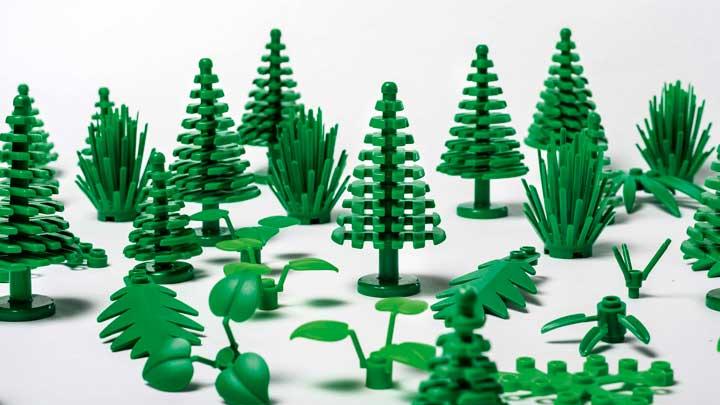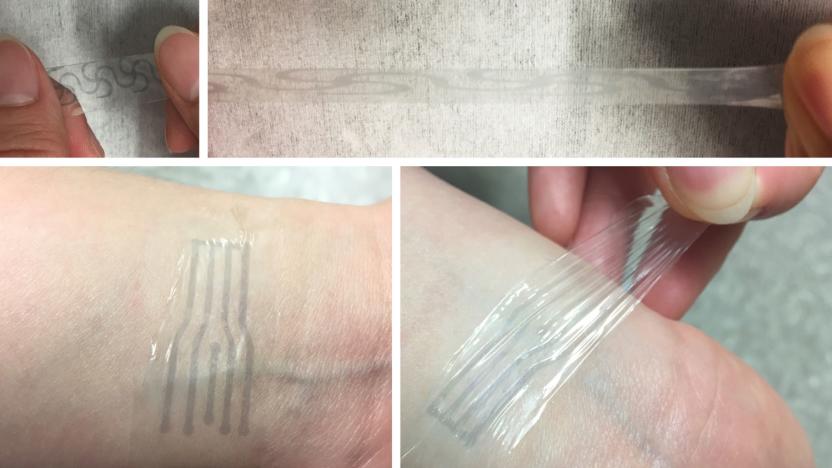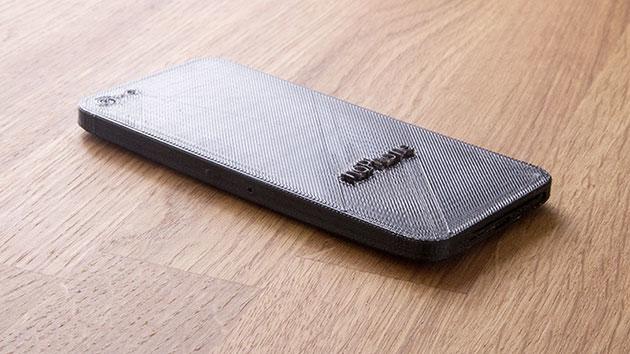plastic
Latest

Lego will soon make bricks out of sugarcane bioplastics
Over the next few years, select Lego pieces will start being made with plant-derived materials as part of the company's pledge to create more sustainable products. Parts resembling leaves, bushes and trees will be made from a polyethylene created with ethanol made from sugarcane. And while these only make up between 1 and 2 percent of all the pieces Lego makes, it's "a great first step in our ambitious commitment of making all Lego bricks using sustainable materials," Lego VP of environmental responsibility Tim Brooks said on its website. These 'green' pieces will be released in sets starting this year.

MIT fires a rocket motor made using 3D-printed plastic
If you're going to 3D-print rocket parts, you'd want to make them out of metal to handle the stress, right? Not necessarily. MIT has successfully test-fired what it believes is the first completely 3D-printed rocket motor to be made with plastic casing. That's right -- an all too easily melted material was sitting a virtual hair's breadth away from super-hot propellant. It sounds like a recipe for disaster, but apparently it worked well -- it generated real thrust, and there was only a small amount of damage to the motor's throat after the initial run. A second test didn't fare so well (it would be useless for moving anything), but MIT hadn't intended for the motor to fire more than once.

ICYMI: Submersible sticky situations and elongating elastomer electrodes
Today on In Case You Missed It: Researchers from Purdue University and the Office of Naval Research teamed up to develop a new kind of glue that even works underwater. The synthetic compound is derived from proteins used by muscles to keep themselves attached to rocks. The man-made adhesive is 17 times stronger than its source material and could one day hold US Navy ships together. We also take a look at a stretchable electrode developed at Stanford University. Leveraging the same kind of molecule that commercial kitchens use to thicken soups, the Stanford researchers were able to develop an electrical conductor that can be easily deformed while actually conducting better as it is stretched. And finally, this is what happens when you hook a watermelon up to a car battery. As always, please share any interesting tech or science videos you find by using the #ICYMI hashtag on Twitter for @mskerryd.

Scientists make stretchy electronics using a soup ingredient
For smart clothing or skin-worn devices to improve, first we need electronics that won't snap like a twig when you move. Using a soup thickener, of all things, scientists from Stanford's Bao Lab created a flexible electrode with "uncompromised electrical performance and high stretchability," said lab director Zhenan Bao. The material could one day be used in better brain-monitoring electronics and smart clothing embedded with heart sensors, LEDs and other tech.

Edible milk-based film preserves food better than plastic
Figuring out how to keep food fresh was a challenge seemingly met by plastics. But as it became clear that spooling out all that synthetic packaging was adversely affecting the environment, interest in greener methods of preservation has spiked. While most containers in your grocery store can be recycled, the thin film stretched over fresh-cut meat can't be — and it's not even that good at keeping food unspoiled. Now, US Department of Agriculture researchers have pioneered a drastically more efficient covering...and it's made out of milk.

Scientists make a 'true' neural network using brain-like chips
Many people have built brain-like neural networks that can learn on their own, but they're typically using plain old silicon to do it. Wouldn't it be better if the chips themselves were brain-like? A mix of Italian and Russian researchers might help. They've created a neural network based on plastic memristors, or resistors that remember their previous electrical resistance. Since they effectively work like brain synapses, they're ideal for creating "true" neural networks where signal transfers create long-lasting effects. And importantly, the choices of technology and materials allows them to be very small (as tiny as 10 nanometers, in theory) without resorting to exotic substances -- you could design a neural network as compact as a regular chip without reinventing the wheel.

Mealworms convert Styrofoam waste into usable soil
Researchers have found a scourge for the 33 million tons of plastic dumped each year in the US: mealworms. A team from Stanford and China's Beihang University found that the beetle larvae stay perfectly healthy eating just Styrofoam, which is normally considered non-biodegradable. Better still, the worms convert the plastic to CO2 and waste that's safe to use as soil for crops. The scientists were as surprised by the discovery as you might be. "There's a possibility of really important research coming out of bizarre places," said Stanford professor Craig Criddle. "This is a shock."

ICYMI: Self-healing plastic, Star Wars gear and more
#fivemin-widget-blogsmith-image-241742{display:none;} .cke_show_borders #fivemin-widget-blogsmith-image-241742, #postcontentcontainer #fivemin-widget-blogsmith-image-241742{width:570px;display:block;} try{document.getElementById("fivemin-widget-blogsmith-image-241742").style.display="none";}catch(e){}Today on In Case You Missed It: We are seriously in awe of the scientific discovery that came from studying squid. Researchers developed a plastic that can reform, no weaker, after getting cut in half-- just so long as water is applied to it. And if you have a couple hundred dollars to blow, you can use it to buy an alarm clock that syncs with Spotify to gently ease you in and out of sleep with a matching glowing light. Also check out the new smart stethoscope product for medical professionals, allowing them to record the heartbeats they hear, then analyze the sounds in an app.

MIT figured out how to 3D print using glass instead of plastic
Researchers at the Massachusetts Institute of Technology unveiled a new 3D printing method on Friday that employs transparent glass as precursor instead of plastic. The method, called G3DP, works basically the same way that conventional 3D printing does though the team found that they could modulate the light transmission, reflection and refraction qualities by precisely varying the thickness of the print.

Plastic roads may put asphalt to shame
The days of putting up with crumbling asphalt streets might just come to an end. Construction company VolkerWessels has revealed plans for recycled plastic roads that are both more sustainable and more practical than old-fashioned blacktop. Besides reusing material, they'd last about three times longer and survive greater temperature ranges (between -40F and 176F) -- despite their fragile look, they're less likely to crack under the strain of vehicles or the weather. You can pre-assemble them to lay them down faster, too, and their hollow structure is handy for cabling and pipes.

Lego is developing eco-friendly plastic bricks
Lego's iconic plastic bricks aren't very kind to the planet since they're made from oil-based ABS plastic, but the toy maker is planning to mend its ways. It's paying $150 million to build a sustainable materials center that will develop oil-free plastic, whether it's made from recycled plastics or an organic material. It's still early going, but the plan is to completely ditch ABS by 2030. This won't have as much of an environmental impact as getting gas-powered cars off the roads. However, Lego makes a whopping 60 billion bricks a year, and estimates that it'd cut three quarters of its carbon dioxide emissions with the switch -- this would still represent a noticeable improvement. [Image credit: Steve Ruark/AP Images for LEGO]

Leave your phone at home without feeling uneasy about it
Finally, there's a device with a spec sheet that'll let you feel good about leaving your other phone elsewhere. Enter the noPhone: a solid brick of plastic that stands in at the size and weight comparable to any of those popular handsets. What's more, the device has a 0-megapixel camera, infinite battery life and is both waterproof and shatterproof. All of that looks good on paper, but the real selling point is how the noPhone's features improve communication. Eye-to-eye contact and conversing with actual spoken words at dinner are on their way back to couples everywhere. That's because you won't be using this slab to text or call someone else, but you can leave it in your pocket to feel like the tether is still intact. No word on a release date or pricing just yet, but you can see the gadget in action on the other side of break.

Stats suggest plastic iPhone 5c is catching up with its prettier sibling
After a couple of high-profile reports about how the plastic iPhone isn't faring too well in the laser-cut shadow of the iPhone 5s, here's a bit of evidence to the contrary. It comes courtesy of stat collectors at an app marketing platform called Localytics, who claim they've spotted a distinct upwards trend in the number of Americans using a 5c relative to a 5s. Whereas usage of the flagship metal iPhone was 3.4x higher during the launch weekend, this ratio has drifted down to 1.9x one month later, suggesting that a secondary wave of not-so-early adopters is happy to give the cheaper model a bit more consideration. Of course, these ratios don't tell us anything about absolute sales figures for either handset -- we'll have to wait on first-hand info from carriers or from Apple itself (perhaps as part of today's event) before we know those.

Low-cost plastic-clad iPhone mentioned in China Labor Watch report
Remember that China Labor Watch report we recently covered? After digging further into the document, 9to5Mac's Computerworld's unearthed more possible evidence about that often leaked, low-cost plastic-clad iPhone. The introduction states: Its assembled products include iPhone 4, iPhone 4s, iPhone 5, and low-priced plastic iPhones. Then, on page 27: Today's work is to paste protective film on the iPhone's plastic back cover to prevent it from being scratched on assembly lines. This iPhone model with a plastic cover will soon be released on the market by Apple. [...] The new cell phone has not yet been put into mass production, so quantity is not as important. Of course, there's no definitive proof that Apple will be launching a more affordable iPhone made of polycarbonate -- after all the company might just be testing prototypes that are not destined to market. Still, the information in this report sure gives all these recent iPhone rumors a lot more merit. Update: It looks like it was Computerworld that originally discovered this information, and we've changed the source link to reflect this.

Plastic skin lights up on contact, may lead to touchscreens everywhere (video)
Flexible circuitry is frequently a one-way affair -- we've seen bendy displays and touch layers, but rarely both in one surface. UC Berkeley is at last merging those two technologies through a plastic skin whose display reacts to touch. By curing a polymer on top of a silicon wafer, the school's researchers found that they could unite a grid of pressure sensors with an OLED screen; they just had to remove the polymer to create a flexible skin. As the film-like material can be laminated on just about anything, it maylead to touch displays in places where they were previously impractical, or even very thin blood pressure sensors. It could also be easy to produce -- since the skins use off-the-shelf chip manufacturing techniques, commercial products are well within reach.

Stanford self-healing plastic responds to touch, keeps prosthetics and touchscreens in one piece
Self-healing surfaces are theoretically the perfect solutions to easily worn-out gadgets, but our dreams come crashing down as soon as deliberate contact is involved; as existing materials don't conduct electricity, they can't be used in capacitive touchscreens and other very logical places. If Stanford University's research into a new plastic polymer bears fruit, though, our scratched-up phones and tablets are more likely to become distant memories. The material can heal within minutes of cuts through fast-forming hydrogen bonds, rivaling some of its peers, but also includes nanoscopic nickel particles that keep a current flowing and even respond to flexing or pressure. The material is uniquely built for the real world, too, with resilience against multiple wounds and normal temperatures. While the polymer's most obvious use would be for mobile devices whose entire surface areas can survive the keys in our pockets, Stanford also imagines wires that fix themselves and prosthetic limbs whose skin detects when it's bent out of shape. As long as we can accept that possible commercialization is years away, there's hope that we eventually won't have to handle our technology with kid gloves to keep it looking pretty.

Datura developer's next act is 'Catzilla,' a PC benchmarking demo
Datura, with its dreamlike presentation and mysterious storyline, was measurably different from most other games. The latest project from developer Plastic Demoscene Group is so different from other games that it isn't even a game!Plastic lives up to its "demoscene group" name with Catzilla, a real-time animated short film intended for use as a PC benchmark. Working with Platige Image, Plastic made a short movie about a giant cat attacking a city, something Datura director Michal Staniszewski said he's "dreamt about for some time."The Vimeo clip above is pre-rendered, of course, but the actual file will be displayed in real time on users' computers to gauge GPU performance. The unusual benchmarking software will go into beta soon. If you want Catzilla to put your computer to the test, sign up here.

Cubify's 3D-printed toy robots take cues from Lego, sport interchangeable parts
If the urge to create a robot petting zoo of your own hasn't subsided since Maker Faire, 3D Systems' new Cubify toy robots might help fill that void in your droid-loving heart. The 3D-printed bots may not boast electronic innards, but their LEGO-like swappable parts allow for some Frankenstein-inspired customization. Ready-made robots start at $4.99, while 3D source files ring up at 99 cents apiece, in case you'd rather extrude them using your own Cube hardware. Yearning to make a personal automaton army entirely of your own design? The company's new beginner-friendly CAD tool, Cubify Invent, should help you craft that unique plastic platoon.

Snapshot: Datura (PS3)
There are so many games out there we couldn't possibly review them all. Welcome to Snapshot, where we highlight games that might fall outside our usual coverage but are still something we think you should know about. Today: Datura for PS3. Standing amongst fallen leaves in an unknown forest, a face stares at me from the side of a tree. It's not a real face, of course, only a mask. Expending considerable effort, I pry the mask from the tree, revealing a hollow behind it. Housed within the hollow is a small pickaxe. Upon grasping the handle, I black out.I wake up in the middle of a frozen wasteland. Crawling along the hard surface, I clear away some snow with my forearm, exposing the ice underneath. It's not a wasteland at all; it's a lake. Beneath the ice is a golden chalice. A noise from behind prompts me to clear away more snow, exposing a horror underneath: A woman is trapped below the ice, and she's still alive.The pickaxe still rests in my hand, so I immediately go to work, chipping away as the woman squirms against the surface. My heart pounds as the axe falls again and again, slowly cracking the ice. Finally, the ice gives way – directly beneath me – and I tumble into the chilly abyss, sinking down as I watch the light of sky recede into nothingness. Again, I awake in the forest, the mask in my hand, which I quickly discard.This is a moment pulled directly from Datura. Did I do something wrong? Something right? I haven't got a clue.

We have to hand it to Datura, this virtual reality rig is impressive
Datura looks like it will be a mind-melting Move masterpiece on its own, but seeing it running on a giant screen with a virtual reality visor, we can't help but be summarily impressed. Check out Plastic's rig in the above video, which features Sony's HMZ-T1 personal projector and a giant hand.











